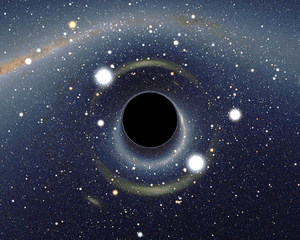Penrose process
The Penrose process (also called Penrose mechanism) is a process theorised by Roger Penrose wherein energy can be extracted from a rotating black hole.[1][2] That extraction is made possible because the rotational energy of the black hole is located not inside the event horizon of the black hole, but on the outside of it in a region of the Kerr spacetime called the ergosphere, a region in which a particle is necessarily propelled in locomotive concurrence with the rotating spacetime. All objects in the ergosphere become dragged by a rotating spacetime. In the process, a lump of matter enters into the ergosphere of the black hole, and once it enters the ergosphere, it is split into two. The momentum of the two pieces of matter can be arranged so that one piece escapes to infinity, whilst the other falls past the outer event horizon into the hole. The escaping piece of matter can possibly have greater mass-energy than the original infalling piece of matter, whereas the infalling piece has negative mass-energy. In summary, the process results in a decrease in the angular momentum of the black hole, and that reduction corresponds to a transference of energy whereby the momentum lost is converted to energy extracted.
The maximum amount of energy gain possible for a single particle via this process is 20.7%.[3] The process obeys the laws of black hole mechanics. A consequence of these laws is that if the process is performed repeatedly, the black hole can eventually lose all of its angular momentum, becoming non-rotating, i.e. a Schwarzschild black hole. In this case the theoretical maximum energy that can be extracted from a black hole is 29% its original mass.[4] Larger efficiencies are possible for charged rotating black holes.[5]
Details of the ergosphere
The outer surface of the ergosphere is described as the ergosurface and it is the surface at which light-rays that are counter-rotating (with respect to the black hole rotation) remain at a fixed angular coordinate, according to an external observer. Since massive particles necessarily travel slower than the speed of light, massive particles must rotate with respect to a stationary observer "at infinity". A way to picture this is by turning a fork on a flat linen sheet; as the fork rotates, the linen becomes twirled with it, i.e. the innermost rotation propagates outwards resulting in the distortion of a wider area. The inner boundary of the ergosphere is the event horizon, that event horizon being the spatial perimeter beyond which light cannot escape.
Inside this ergosphere, the time and one of the angular coordinates swap meaning (time becomes angle and angle becomes time) because timelike coordinates have only a single direction (and remember the particle is necessarily rotating with the black hole in a single direction only). Because of this weird and unusual coordinate swap, the energy of the particle can assume both positive and negative values as measured by an observer at infinity.
If particle A enters the ergosphere of a Kerr black hole, then splits into particles B and C, then the consequence (given the assumptions that conservation of energy still holds and one of the particles is allowed to have negative energy) will be that particle B can exit the ergosphere with more energy than particle A while particle C goes into the black hole, i.e. E(A)=E(B)+E(C) and say E(C)<0, then E(B)>E(A).
In this way, rotational energy is extracted from the black hole, resulting in the black hole being spun down to a lower rotational speed. The maximum amount of energy is extracted if the split occurs just outside the event horizon and if particle C is counter-rotating to the greatest extent possible.
In the opposite process, a black hole can be spun up (its rotational speed increased) by sending in particles that do not split up, but instead give their entire angular momentum to the black hole.
See also
References
- ↑ R. Penrose and R. M. Floyd, "Extraction of Rotational Energy from a Black Hole," Nature Physical Science 229, 177 (1971).
- ↑ Misner, Thorne, and Wheeler, Gravitation, Freeman and Company, 1973.
- ↑ Chandrasekhar, pg. 369
- ↑ Carroll, pg. 271
- ↑ http://www.ias.ac.in/jarch/jaa/6/85-100.pdf Energetics of the Kerr-Newman Black Hole by the Penrose Process; Manjiri Bhat, Sanjeev Dhurandhar & Naresh Dadhich; J. Astrophys. Astr. (1985) 6, 85 –100 - www.ias.ac.in
Further reading
- Chandrasekhar, Subrahmanyan (1999). Mathematical Theory of Black Holes. Oxford University Press. ISBN 0-19-850370-9.
- Carroll, Sean (2003). Spacetime and Geometry: An Introduction to General Relativity. ISBN 0-8053-8732-3.
